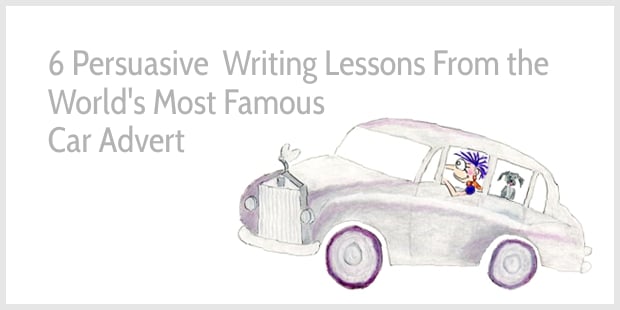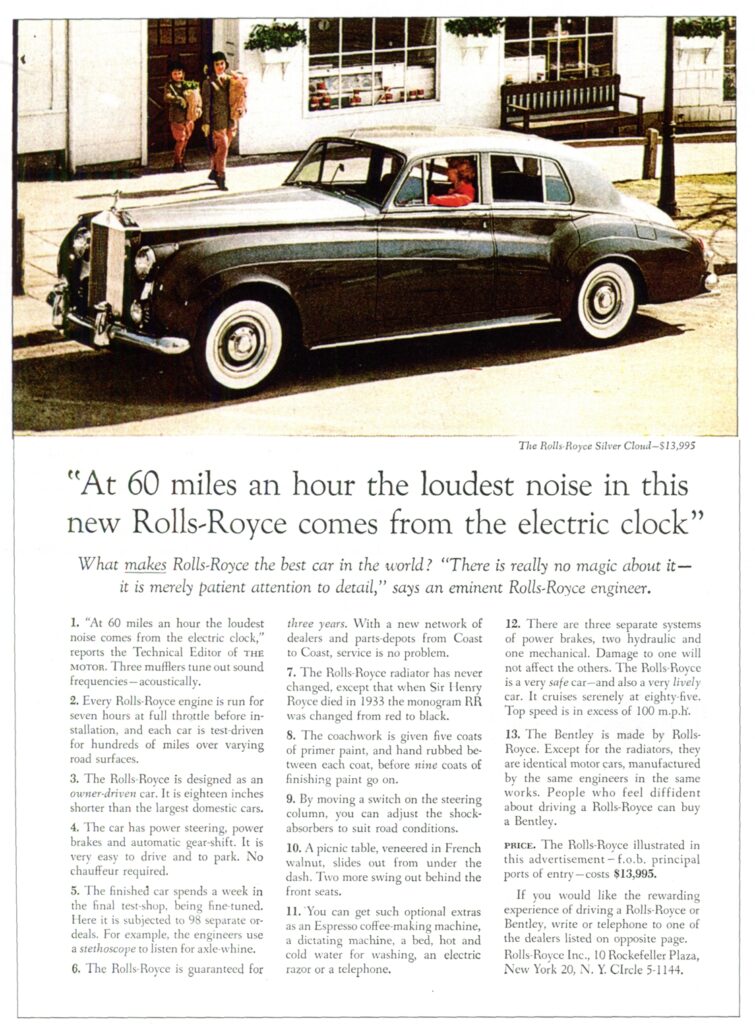
“I love, love, LOVE David Ogilvy,” D. said to me.
“You know that Rolls-Royce ad?”
“Yeah,” I mumbled.
“An analysis by you would be soooo good,” said D. “I’d love to understand what makes his writing so persuasive.”
Pretty, please?
I am not a big David Ogilvy fan …
I half-read, half-skimmed his two famous books—the ones that appear on most lists with book recommendations for copywriters.
Ogilvy’s books mostly explain how to find a job in advertising, how to get and manage clients, and how to run an agency. I’m more interested in writing, and only a couple of his book chapters teach copywriting.
And furthermore, Ogilvy comes across as a sexist. Just read his sales manual on cookers (1935) and you’ll know what I mean.
But okay.
D. is right.
Ogilvy is the father of advertising. He knew how to research and write good copy. Studying his adverts will help improve your copywriting skills.
So, shall we have a look?
Below follow 6 timeless copywriting lessons from Ogilvy’s Rolls-Royce advert, probably the most famous car advert ever, still studied by copywriters decades after it first appeared in 1958.
1. Lead with a big idea
A good headline communicates succinctly what’s special about the product advertised:
At 60 miles an hour the loudest noise in this new Rolls-Royce comes from the electric clock.
In his Confessions of an Advertising Man, Ogilvy claims that the headline of the Rolls-Royce advert is the best headline he’s ever written.
But that’s not true.
Ogilvy did not write that headline.
When he won the Rolls-Royce account, Ogilvy spent 3 weeks reading about the car, and the headline is a quote from the Technical Editor of The Motor magazine.
We often think of writing as a creative activity.
But writing sales copy is less about being creative and more about re-using words and ideas from people who know best such as customers, potential customers, product developers, and experts.
Ogilvy’s famous Rolls-Royce headline expresses a sense of luxury—a car so well-engineered that it’s quiet, comfortable, and a joy to drive. This sense of luxury is believable thanks to the specific fact that the loudest noise comes from the electric clock.
The advert is not selling a car, it’s selling a driving experience.
Your copy tip:
To write better copy, consider what kind of experience your readers are looking for. Don’t make this up. Speak to customers and read reviews to understand how your product or service can connect with their needs and wishes.
2. Communicate the true benefits
Good copy translates features into benefits.
The features explain specific facts about the product, and the benefits explain why those features matter to customers.
For instance, the Rolls-Royce advert mentions benefits like safety, serenity, and the joy of driving (it’s lively):
There are two separate systems of power brakes, hydraulic and mechanical. The Rolls-Royce is a very safe car—and also a very lively car. It cruises serenely at eighty-five. Top speed is in excess of 100 m.p.h.
Sales copy becomes more persuasive when it explains a variety of true benefits. For instance:
- Physical and financial needs: The car is safe, as mentioned above.
- Social needs: The car is not for modest people: “The Bentley costs $300 less, because its radiator is simpler to make. People who feel diffident about driving a Rolls-Royce can buy a Bentley.” (diffident means modest)
- Spiritual needs: The car drives serenely and it’s lively.
Covering a variety of benefits helps paint the full experience that your product or service offers.
Your copy tip:
To write persuasive copy, consider what your customers truly want. How does your product or service improve their lives? Where possible, cover benefits across physical, financial, social, and spiritual needs.
3. Don’t brag without substance
It’s never enough to tell readers how good your product or your service is.
Why would they believe you?
Always, ALWAYS back up your statements with proof.
That proof can come in two ways. One way is to borrow credibility from experts and existing customers. Let them explain why your product is so good.
Ogilvy not only quotes the Technical Editor of The Motor magazine. He also quotes a Rolls-Royce engineer:
What makes Rolls-Royce the best car in the world? “There is really no magic about it—it is merely patient attention to detail,” says an eminent Rolls-Royce engineer.
Quoting your own employees may be a little iffy. But it works because that statement about attention to detail is backed up with plenty of facts, such as:
The finished car spends a week in the final test-shop, being fine-tuned. Here it is subjected to ninety-eight separate ordeals. For example, the engineers use a stethoscope to listen for axle-whine.
Notice how specific that short paragraph is. The car doesn’t just go through a unspecified series of tests. No, the facts about the tests are specific, reinforcing the concept of quality and attention to detail:
- Each car spends a week in the final test-shop.
- It’s subjected to 98 tests.
- The engineers listen for axle-whine with a stethoscope.
Each short paragraph in this advert mixes specific facts with true benefits, and that makes it interesting, credible, and persuasive.
Your copy tip:
Want to write better copy, too? Add facts and testimonials to demonstrate how good your product or service is.
4. Explain fuzzy concepts
Communicating the quality of a product helps justify a higher price point.
But how?
Ogilvy refers to the quality of other well-known products to help explain the quality of the Rolls-Royce. For instance:
The seats are upholstered with eight hides of English leather—enough to make 128 pairs of soft shoes.
The target audience of this advert will know the luxurious feeling of an expensive, soft-leather shoe compared to the discomfort of a cheaper, more rigid shoe. The walking experience is completely different, and so is the driving experience.
Ogilvy also associates the quality of car engines with aircraft engines, a far more complicated and expensive proposition:
Rolls-Royce engines power more than half the turbo-jet and prop-jet airliners supplied to or on order for world airlines.
That line also reinforces that Rolls-Royce is a market leader. Nice!
Almost every line in the Rolls-Royce advert helps create an image of a high-quality product built with attention to detail to deliver a luxurious (and safe and easy) driving experience.
Your copy tip:
Think about the image you want to exude in your sales copy, and use specific details to illustrate fuzzy concepts like ease of use, attention to detail, high quality, and excellent customer service.
Let people imagine what it’s like to work with you or to use your product.
5. Overcome objections head-on
Before Ogilvy became an advertising man, he worked as a salesman for a British cooker company. He wrote a manual on selling cookers for his colleagues, and a large part of that manual is devoted to overcoming people’s objections to buying his cooker.
In advertising, he takes a similar approach.
For instance, at the time the Rolls-Royce advert appeared, people may have been concerned about the difficulties of driving and parking a car. Ogilvy’s copy reassures them:
The car has power steering, power brakes and automatic gear-shift. It is very easy to drive and to park. No chauffeur required.
Worried about lack of service? Again, Ogilvy addresses this objection:
The Rolls-Royce is guaranteed for three years. With a new network of dealers and parts-depots from Coast to Coast, service is no longer any problem.
Here’s one key to Ogilvy’s success … He only wrote adverts for products he believed in. When the quality of Rolls-Royce cars nose-dived and 500 defective cars turned up in the US, he resigned the account.
But when he wrote his famous Rolls-Royce advert? He believed in the product, and that belief shines through the copy. He was comfortable taking on any potential objections. No need to pussyfoot around.
Your copy tip:
Consider why people might might hesitate to buy your product. How can you overcome those hesitations in your copy?
6. Be interesting
While reading Ogilvy’s advert, I feel like I’m learning something about Rolls-Royce cars. The facts are interesting and precise, and Ogilvy clarifies why the facts matter:
By moving a switch on the steering column, you can adjust the shock-absorbers to suit road conditions. (The lack of fatigue in driving this car is remarkable.)
One way to be interesting is to educate readers by explaining a string of feature–advantage–benefit, like the line above does:
- The feature is the switch.
- The advantage of the switch is that you can adjust the shock-absorbers to suit road conditions.
- The true benefit of adjusting the shock-absorbers is that you don’t get fatigued driving.
Ogilvy educates readers with interesting tidbits about the car. The information is technical, but never feels too technical. As Ogilvy suggests, “You cannot bore people into buying your product; you can only interest them in buying it.”
Your copy tip:
Technical details can make your sales copy more interesting. Explain the advantage of each detail and clarify how that advantage delivers a true benefit.
Why was Ogilvy so successful?
In June 1986, Joel Raphaelson interviewed David Ogilvy for Viewpoint, the Ogilvy & Mather magazine.
Raphaelson asked Ogilvy what made him successful, and Ogilvy mentioned the following 3 points:
- “I’m the most objective man who ever lived, including objective about myself.” (Ahum, really?)
- “I’m a very, very hard worker.”
- “I’m a good salesman.”
As writers, we often worry about creativity. But good copy is assembled from research.
That assembly process needs some creativity but not a lot.
Ogilvy doesn’t mention creativity as one of his strengths. He even says:
I had a reasonably original mind, but not too much so. Which helped, not being too original.
Ogilvy’s experience in sales and in research helped him become one of the world’s best copywriters.
He put in the hard work of gaining a deep understanding of both products and customers.
And that understanding helps make his sales copy interesting, credible, and persuasive.
PS
Thank you to vocal coach Dylan for inspiring this post.
PPS
Here’s the Rolls Royce advert (click on the image to enlarge):
Enchanting Copywriting course
Learn how to write a persuasive sales page
without selling your soul
![]()
Reading and doing the exercises taught me how to judge my own work, and Henneke’s copywriting system helped me put my sales page together, step by step. Definitely 5 stars.
~ Jackson Lamar
![]()
“I’m running my refreshed marketing campaign right now and I’m seeing increased open and click-through rates on newly written emails. Better yet, I’m seeing increased sales and less questions from prospective customers, which tells me I answered all their questions and inspired them to buy through my more compelling copywriting. This course is a wise investment that earns itself back quickly.”
~ Karyn Greenstreet
Further reading on David Ogilvy:
- Confessions of an Advertising Man
- Ogilvy on Advertising—This book includes the story of how Ogilvy wrote the Rolls Royce advert.
- The Unpublished David Ogilvy—This book includes “The Theory & Practice of Selling the Aga Cooker”—the sales manual Ogilvy wrote for his door-to-door sales colleagues; it also includes the interview with Joel Raphaelson for Viewpoint.
Recommended reading on learning copywriting:
How to teach yourself copywriting (on a shoestring budget)
5 shrewd tips from 5 famous copywriters
20+ writing examples: Discover how to emulate good writing




This post is info-packed.
I had a good time reading it.
I’m glad you enjoyed it, Tobenna. Thanks so much.
Wow. I’ve been a professional copywriter for twenty years and I’ve read countless articles on copywriting and this piece has to be one of the best if not the best. Although, I am sure (perhaps hopeful?), that had Ogilvy lived in 2022 he too would have been an inclusive man of our times.
Wow. What a lovely compliment. Thank you, Colin.
And yes, it’s possible that Ogilvy would have become more inclusive if he’d been a bit younger and still lived today.
Hi Henneke,
It was a very informational read! I am a marketer who is trying to write a fiction book. I am learning a lot from your articles, and the tips you shared in this one will definitely help me evolve as a marketer and writer as well. So, thanks a lot for sharing this amazing resource. I learned a lot from it and will be using these tips in my strategies and process. Looking forward to reading more of your amazing articles.
A lot of people seem to think that creative writing is completely different from marketing writing. But it’s all writing. So, while there are of courses differences, we can learn techniques from any good writer and apply our learning to any type of writing. Happy writing, John!
I have been an Ogilvy fan for years, partly because as a professional book editor and lifelong reader I appreciate how clearly yet compassionately he always wrote.
Thanks for the reminder of his copywriting principles. Changing a word here and there makes them valuable hints for author clients as well.
He was an excellent copywriter & editor.
Copywriters are always coming up with new ways to write better, more engaging content. But it’s not just a job for them – copywriting is in your blood.
For every writer there’s nothing like reading an amazing work or getting inspired by someone else who can do what you want on paper if only they had enough time and energy….
Thanks Henneke
I love writing and reading and getting inspired by other authors. How lucky I am to be blogging about writing!
You must put Ogilvy’s writing into perspective. Advertising in those days was all sexist gumph. Things have changed – thank heavens. He was a brilliant copywriter and a very interesting man.
I understand the historical perspective and I understand that when Ogilvy was selling cookers, he was mostly selling to housewives. But even in his later days, he didn’t seem to understand the advantages he had enjoyed simply because he was a man. I agree he was a brilliant copywriter and he’s interesting (that’s why I wrote this post!) but that doesn’t mean I need to be a big fan.
We always have something new to learn from the first copywriters. Thanks Henneke to inspire better writing day by day and the best way to say it by words. A big hug from Argentina.
I’m glad you enjoyed this, Fran. Sending a big hug back across the big pond!
Terrific post/article!
Thank you, Sheila 🙂
Thank you for such a good analysis of a classic ad! You are so right about it all. 🙂
Thank you, Emma! 🙂
Such a great analysis Henneke. Even if those are concepts I already knew you have the skill to make them sound fresh in my mind. Never a dull post!
I love Ogilvy because he was a great adman and we can learn lots from his work. Same as you, I prefer not to think too much about his morals! 🙂
Big hug from Barcelona
That’s such a lovely compliment. Thank you, Elena. I did my best to make the post interesting. And I’m glad you agree with my view on Ogilvy. 🙂
I hope you’re enjoying your time in Barcelona!
You actually punished me when I began reading your article! Before, I wanted to use the rest room, however just taking a glance at your first paragraph I could not takes my eyes off until finished. Awesome article !!
Oops. I’m sorry about the accidental punishment, Trevor. I hope you survived without accidents.
The quality I like most about you is your understated approach. Your writing and choice of words reflect this in good measure.
I am on your mailing list and receive your emails.
Believe me when I say I look forward to receiving your mail!
Such lovely feedback! Thank you, Ram.
I read somewhere that writer’s block, (especially when coming up with benefits),can be tackled with tons of research.
I think I need to dig into this idea deeper.
Loved this post. Pure gold. Thanks.
P.S. Sorta related to research about life and stuff. I just started a cool read,
“Wild Souls; Freedom and Flourishing in the Non-Human World,” by Emma Marris.
Disclaimer, it has animals in it. And how they are important to, well, everything.
David Ogilvy hated writing his first draft. This is from “The Unpublished David Ogilvy:”
“At this point I can no longer postpone doing the actual copy. So I go home and sit down at my desk. I find myself entirely without ideas. I get bad-tempered. If my wife comes into the room I growl at her. (This has gotten worse since I gave up smoking.)
I am terrified of producing a lousy advertisement. This causes me to throw away the first 20 attempts.
If all else fails, I drink half a bottle of rum and play a Handel oratorio on the gramophone. This generally produces an uncontrollable gush of copy.”
Sounds a bit like a writer’s block, too, doesn’t it? So, sometimes one can solve writer’s block by doing more research and at other times, one has to force oneself to write that ugly first draft. It can be tricky to know which of the two it is!
Thanks so much for the book recommendation. I’ll check it out.
Whoa!
Ogilvy is a god in the advertising world. Almost every article or blog post I have read just “gushes” over his achievements.
You make it clear he is not your favorite person. Yet, you wrote a completely fair and objective analysis of his amazing professional work.
Then you integrated your very insightful “Your Copy Tip” for each section.
I admire your professionalism and honest approach in crafting this post.
Thank you so much for your comment, Mike. I like your analysis of this post. I guess I’m not a hero worshipper but I do appreciate good copy (and good writing in general).
I don’t like his books either!
Why do you call this stealing? ‘he “stole” the headline from the Technical Editor of The Motor magazine.’
So many things get copied online, I am always afraid to use that term. Listening to your customers: yes. Stealing from collegues: hm..
I know you do not like ‘stealing’ yourself!
That’s a fair point. He uses the quote with full credit so it’s not stolen but used properly. I’ll think about using a better word. Thank you for mentioning this.
And yes, many people copy stuff online, often without proper credit. Sometimes, it’s in bad faith but quite often it seems people just don’t know how they should properly quote people.
Wow, so well said. I have read most of Ogilvy’s books long ago. Nice to get a fresh take on it. Thank you!
I’m glad you enjoyed it, Cay. Thank you for stopping by.
Hi Henneke, in your opinion is writing an article very different to writing a sales page?
I’m curious, as an article (I believe) is often a persuasive piece of copy, an insightful curation of words designed to produce wonder or further reflection, and a call to action hoping to shift perspective.
Well … that’s what I hope to achieve with my own writing.
Would love to hear your thoughts – and if you have a program to further develop skills in this area.
There’s definitely overlap between writing a sales page and writing an article. Both pages have to do some education and some selling but an article is more focused on educating while a sales page is more focused on selling. A sales page sells a product or service, an article sells an idea.
One of the big differences is that with a sales page you have a more or less fixed call to action (to buy or to ask for a quote or book a discovery call etc.) so you have to be sure that you share everything required to get people to buy. For an article, you have more flexibility. You can define what the call to action is: What do you expect a person to do after reading the post? Do you change their mindset? Get them to try out a tip? You can decide how big or how small the expected change and that’ll help shape your article. For instance, by making the tip smaller, you can make your writing more vivid and make sure that people actually implement your advice.
And yes, I have a course that teaches how to write blog posts that captivate, educate, and inspire readers. You can find all details here: https://www.enchantingmarketing.com/blog-writing-course/
Let me know if you have further questions?
Excellent learning on writing a powerful and emotional copy my Enchanting Henneke
The most important thing I learned is – Do your research thoroughly to the unmet needs of customers and address them!
Thank you, Vivek. And that’s a great takeaway from this post.
Brilliantly written article, some great advice from “the most objective man who ever lived” 🙂 The one that totally resonated was actually believing in the product – only then copy can be truly genuine. Thanks for sharing!
Thank you, Nata. I also thought it was interesting that he resigned the account when he stopped believing in the product.
Thank you for this! I love it and got some great insight that I had missed when I read it.
I’m so glad you like it! It was written for you 🙂
Hi Henneke,
I love how you showed us examples of leading with benefits. Not only that but how to be creative with those sentences. Everyone has problems and is looking for solutions online. The key is for us to provide benefits and have them find our solutions to their problems with interesting and persuasive content.
Thank you!
Yes, that’s a good summary! I’m glad you enjoyed this, Lisa. Thank you for stopping by.